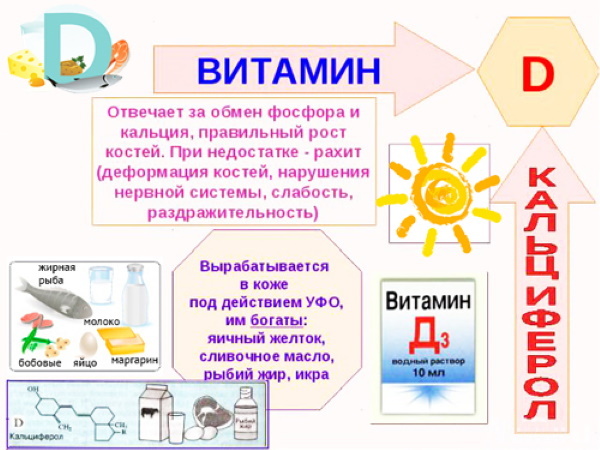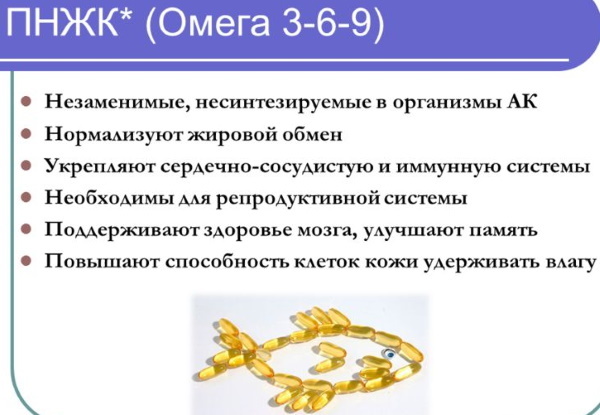Mirroll's fish oil is an excellent remedy for general strengthening of the body, rich in vitamins D and A, contributing to the improvement of brain and vision, as well as the growth of bones. There are many positive reviews about this drug, because the benefits of fish oil have been known since ancient times. For several centuries it has been used both for medicinal and prophylactic purposes.
Record content:
- 1 Terms of dispensing from pharmacies, drug price
- 2 Composition, release form
- 3 Principle of operation and efficiency
- 4 Indications for use
- 5 Application for cardiovascular diseases
- 6 The effect of the drug on immunity and vision
- 7 Application in the treatment of rickets
- 8 Application in the treatment of night blindness
- 9 Contraindications and adverse reactions (list)
- 10 From what age is it allowed to take?
- 11 How to use the medicine correctly
- 12 Interaction with other drugs
- 13 special instructions
- 14 Storage conditions and periods
- 15 Fish oil video
Terms of dispensing from pharmacies, drug price
The drug can be dispensed from pharmacies without a prescription. The cost of the drug depends on the form of release (capsules in a package or liquid in vials). Mirroll's fish oil in capsules is produced in cardboard packages and costs from 80 to 120 rubles. (the exact price depends on the number of capsules in the package).

Fish oil in the form of a liquid is produced in glass bottles and costs about 50 to 90 rubles. (depending on the volume of the bottle).
Composition, release form
The preparation contains the following components:
- Fish fat.
- Gelatin.
- Antioxidant.
- Glycerol.
The drug is available in the form of enteric capsules or in vials in liquid form. Capsules are made from gelatin and glycerin. Capsules of 0.35 g or 0.55 g are on sale, which are packed in plastic bags of 100 or 200 pcs., And then in cartons. Mirroll vials are usually available in 50 ml or 100 ml volumes.
Principle of operation and efficiency
Mirroll's fish oil, reviews of which positively characterize this drug, contains vitamins A and D necessary for the body. Due to the presence of polyunsaturated fatty acids of the OMEGA-3 group in fish oil, its use reduces the risk of cardiovascular diseases, improves bone growth, stimulates the absorption of phosphorus and calcium, improves vision.
Operating principle:
- Vitamin A is involved in bone growth, ensures the functioning of redox reactions, used in the production of proteins, lipids and mucopolysaccharides, as well as for the production of pigments vision.
- Vitamin D improves the absorption of phosphorus and calcium by the body, strengthens bone tissue, strengthens the nervous and immune system, helps to restore and strengthen the cardiovascular system, normalizes the work of the parathyroid glands.

- The assimilation of retinol (vitamin A) occurs in the digestive tract through interaction with bile acids. When retinol interacts with the villi of the duodenum, retinyl palmitate is formed, which is transported through the lymph to the liver. During transportation, retinyl palmitate interacts with lipoproteins and hepatocytes, resulting in the cleavage of chylomicrons, and then the production of retinoic acid. Further, retinol combines with albumin and is delivered through the blood to organs that need this element.
The highest concentration of retinol is found in the liver and retina. The content of the substance is slightly less in the lungs, kidneys and adrenal glands, as well as in the heart. Vitamin D is absorbed in the small intestine, where bile is used to break it down. As a result, cholecal-cypherol is produced in chylomicrons.
The transport of this substance through the body is carried out together with gamma globulins. The concentration of the substance is maximum in bone tissue, and in the liver and muscles it is not so pronounced.
Retinol metabolism occurs under the action of glucuronic acid, as a result of which retinoic acid is produced, which is subsequently excreted in the bile.
The time for excretion of this acid from the body is 3-5 weeks. Molecular transformations of vitamin D take place in the liver, kidneys and skin. Vitamin D3 appears in the skin tissue, and oxycholecalciferol is produced in the liver, which, when it enters the kidneys, is converted into dihydrooxycholecalciferol. Excretion of the substance from the body occurs mainly with bile.
Indications for use
Fish oil is prescribed in the following cases:
- Lack of vitamins D and A in the body.
- With anemia.

Mirrolla fish oil can be used for anemia. - With rickets.
- With night blindness.
- For the prevention of cardiovascular diseases.
The drug is also prescribed in complex therapy for the prevention of cardiovascular diseases, for strengthening bone tissue and general strengthening of the body with avitominosis.
Application for cardiovascular diseases
Mirroll's fish oil, reviews of which speak of its benefits in cardiovascular disorders, is widely used in cardiac therapy. Research into the effects of OMEGA-3 polyunsaturated fatty acids on the cardiovascular system began in 70s, when it was noticed that among the population of Greenland there was a fairly low incidence of coronary disease hearts.
This is due to the fact that the inhabitants of the coastal areas ate mainly fish, which had a positive therapeutic effect. As a result of research, it was confirmed that fish oil has a positive effect on myocardial metabolism and reduces the risk of developing arrhythmias, as well as improves the body's immune system.
Eating fish 2 times a week provides the necessary supply of OMEGA-3 fatty acids. The following table shows the fish species and the amount of polyunsaturated fatty acids, as well as docosahexaenoic and eicosapentaenoic acids, that are contained in OMEGA-3.

| Type of fish | Omega-3 (in 100 g of product) | DHA (in 100 g of product) | EPA (in 100 g of product) |
| Trout | 0,7 | 0,55 | 0,15 |
| Sardine | 2,6 | 1,5 | 1,1 |
| Salmon | 1,4 | 0,6 | 0,8 |
| Cod | 0,4 | 0,25 | 0,15 |
| Cod liver | 19 | 10 | 9 |
During experimental studies on rats and rabbits, it was proved that fish oil has an anti-atherogenic effect and slows down the development of cholesterol atherosclerosis. The indicators of hemostasis demonstrated a positive trend in anti-thrombotic therapy.
Due to the increased production of prostacyclin and a decrease in the production of prostaglandin, platelet aggregation slowed down, and the duration of blood clotting was reduced. DHA and EPA acids suppress the actions of monocytes and neutrophils, reduce the concentration of leukotriene and increase the activity of anti-inflammatory prostaglandins.
The following changes in blood biochemical parameters were established during therapy with polyunsaturated fatty acids:
- Reducing the amount of triglycerides by 25-70%.
- Reducing cholesterol levels by 30-60%.
- Decrease in the level of VLDL in the blood.
- An increase in the amount of type B apoprotein protein and a decrease in A1 apoprotein.
Changes in blood counts reached the above values 10 days after the start of fish oil treatment. Also, it was found that fish oil helps to normalize blood pressure, as well as various cardiovascular disorders.
In 2003 g. a large-scale study was carried out in Italy on the therapeutic effects of fish oil in patients after ischemic myocardial infarction.
The study involved 11,000 patients, half of whom for 5 years (with some frequency) took polyunsaturated fatty acids of the OMEGA-3 group, and the other half of the patients adhered to the standard prevention of this diseases.
After 4 months, the number of deaths (due to ischemic heart disease) in the first group decreased by 1% relative to the second group. After a few years, this difference reached 20%, which confirmed the anti-atherosclerotic properties of fish oil.

After these studies, the American Heart Association and the All-Russian Scientific Society of Cardiology of Russia approved recommendation on taking drugs based on OMEGA-3 polyunsaturated fatty acids in order to prevent cardiovascular diseases.
The effect of the drug on immunity and vision
Mirroll's fish oil, reviews of which confirm the positive effect of the drug on immunity and vision, used in the complex therapy of acute respiratory viral infections, as well as additional biological additives in ophthalmology.
The main components of fatty polyunsaturated acids, which are involved in the formation of membranes of brain cells, neuroretina, as well as anti-inflammatory and immune responses, are eicosapentatene (EPA) and docosahexaenoic (DHA) acid. DHA, along with arachidonic acid, affects the receptor functions of the body, as well as enzymatic activity.
The brain and retina of the eye have the greatest need for these acids, in contrast to other organs. The amount of DHA in the phospholipids of the organ of vision is 65% of all polyunsaturated fatty acids affecting formation of rhodopsin (vision pigment), which is fundamentally necessary for the functioning of the retina.
In the phospholipids of the brain, the amount of these acids is 20% of the total amount of polyunsaturated fatty acids. In 2008 a study was carried out of the effect of OMEGA-3 polyunsaturated fatty acids on the resistance of children to respiratory viral diseases, as well as on the possible improvement of visual function.

The study involved 49 children aged 6 years, who were divided into 2 groups. The first group received fish oil capsules (3 capsules per day, 0.25 g), while the second group received placebo capsules with sunflower oil.
The first phase of the study lasted 90 days (during seasonal flu from October to December), during which the number of children from the first group who missed school due to ARVI turned out to be 35% less than the number of cases from the second groups.
The second stage lasted the entire winter-spring period (from January to March), during which the number of sick children in the first group relative to the first decreased by another 30%. Thus, consumption of fish oil for more than 6 months reduced the incidence of respiratory diseases by 65%.
With the further use of fish oil by children from the first group, a further decrease in the increase in the incidence was revealed. The presence of vitamins A and D, which are part of fish oil, stimulates the immune system in the fight against ARVI and various respiratory infections.
The study of the effect of polyunsaturated fatty acids on visual function was assessed according to the SPF (spatial contrast sensitivity). This indicator is the lowest contrast value at which the shape and color of an object or image can be recognized by the retina.
The higher the contrast sensitivity of the eye, the better a person perceives and recognizes the properties, shapes and colors of objects around him. The study of the PCC was carried out using a special computer program SPSS 10.5. In the process of taking fish oil for 7 months in the first group, an increase in the contrast sensitivity index by 10% was revealed.
The increase in the values of the indicator began as early as 2 months of consumption of fish oil. Analysis of the characteristics of the retina revealed improved sensitivity in the range of medium and low frequencies of green and red gratings, which confirms the improvement in the quality of the pathways of the visual analyzer, as well as the improvement in the functioning of the main systems of the retina eyes.
Application in the treatment of rickets
The occurrence of rickets in infants and young children is associated with a lack of vitamin D and a deterioration in phosphorus-calcium metabolism. As a result, bone mineral saturation decreases, which leads to a decrease in bone growth.

The use of OMEGA-3 polyunsaturated acids in early childhood can compensate for vitamin D deficiency, but dosing should be taken with caution this remedy for children, since fish oil in large quantities can lead to an overdose of vitamin A, which can lead to various negative side effects reactions.
A safe dosage for children under the age of 1.5 years is 50 mg of the drug per 1 kg of the child's weight per day. For children aged 1.5 to 5 years, 30 mg per 1 kg of body weight is sufficient. Older children can use fish oil capsules.
Application in the treatment of night blindness
Patient reviews on the effectiveness of the use of Mirolla fish oil in the treatment of night blindness are in most cases positive. The occurrence of night blindness is associated with a lack of vitamin A in the body. With such a disease, a person cannot see in low or twilight lighting, and color sensitivity to yellow and blue colors also decreases.
Long-term vitamin A deficiency can occur due to its absence in food or as a result of impaired absorption of this vitamin by the body. Symptoms of night blindness include inflammation of the eyelids, dry eyes, and skin rashes or blemishes.
The cause of night blindness can be not only a deficiency of vitamin A, but also various kinds of disorders in structure of the eye (cataract, retinal degradation, glaucoma, decreased sensitivity of the visual nerve). In addition to all this, there is congenital night blindness, which does not respond to treatment.
If the cause of the disease is a lack of vitamin A, prescribe food rich in this vitamin (various types of fish, spinach, carrots), as well as fish oil. For treatment, you can use OMEGA-3 polyunsaturated fatty acids in capsule form, which is very convenient.

The use of fish oil for such a disease should continue for several months 3 times a day, 1-2 capsules (0.5 mg per capsule). It is also recommended to consume berries and fruits rich in vitamins for the eyes (black currants, blackberries, gooseberries, blueberries).
Contraindications and adverse reactions (list)
Mirroll's fish oil, reviews of which are mostly positive, still has some side effects.
The use of the drug is contraindicated in the following cases:
- Oversaturation of the body with vitamins D or A.
- The presence of stones in the gallbladder.
- Intolerance to the components of the drug.
- Various skin diseases.
- Kidney or liver disease.
- The presence of hypercalciuria or hypercalcemia.
- Various granulomatosis.
- Pancreatitis

- Pregnancy.
From what age is it allowed to take?
The drug is allowed to be taken by adults and children from 4 years of age.
How to use the medicine correctly
The dosage of the drug depends on the form of its release. Capsules are taken 1-3 times a day, 1-2 pcs. They should be washed down with plenty of room temperature water.
The capsules cannot be kept in the mouth for a long time, as their shell may dissolve ahead of time or become sticky for further swallowing. If liquid fish oil is used in vials, it is taken 1-3 times a day for 1 tbsp. l.
The sequence of actions for taking liquid fish oil is as follows:
- Open the bottle by carefully removing the cap.
- Pour fish oil into a tablespoon (it should not be completely filled to avoid spilling the product when taken).
- Drink the contents of the spoon in one gulp.
- Close the bottle tightly.
Liquid fish oil can be given to children aged 1 year and older (no more than 0.4 tsp. l. in a day). Children under 7 years old can take 1-2 tsp. l. in a day. The duration of admission is usually 1 to 3 months.
Interaction with other drugs
While taking the drug, the following side effects can be observed:
- Fishy breath.
- Minor allergic reactions.

- Increased symptoms of chronic cholecystitis and pancreatitis.
While taking the drug in conjunction with glucocorticoids, it is possible to reduce their anti-inflammatory properties. The use of neomycin, clestipol, or cholestyramine reduces the absorption of vitamin A. The use of estrogens and calcium can lead to hypervitaminosis and hypercalcemia.
The use of anticonvulsants reduces the absorption of vitamin D.
When used simultaneously with isotretinoin, its toxic effect on the body may increase. When used together with tetracycline, intracranial hypertension may occur. The use of phosphorus-containing drugs together with fish oil can cause hyperphosphatemia.
special instructions
The drug should not be taken in conjunction with other medicines containing vitamins D and A. Excessive use of this drug can lead to hypervitaminosis.
The use of the drug does not violate the concentration of attention and the quality of control of various mechanisms and vehicles. If symptoms of an overdose occur, the drug should be discontinued immediately.
These symptoms include:
- Intoxication (dry mouth, bone pain, nausea).
-
Vitamin A overdose (dizziness, impaired concentration, confusion, intracranial pressure).

- Vitamin D overdose (stool disturbance, thirst, arrhythmia, nausea, weakness, taste of iron in the mouth).
Storage conditions and periods
The shelf life of the drug is 2 years. The drug should be stored in a dry and dark place at a temperature not exceeding 26 ° C. The storage location should not be accessible to children.
Mirroll fish oil is produced from Norwegian salmon and is a complete source of OMEGA-3 polyunsaturated fatty acids. The product meets the European quality standard and has a lot of positive feedback from customers. The availability of the form of release of this agent in the form of capsules is very convenient and practical to use.
Fish oil video
What are the benefits of taking fish oil:



